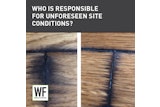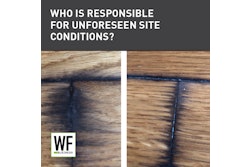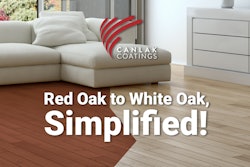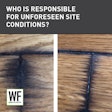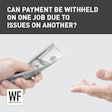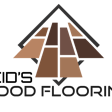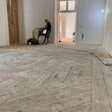
The Homeowner’s Issue
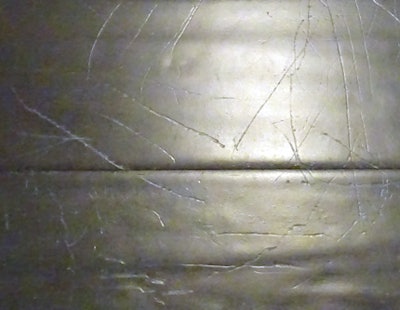
The homeowner noticed marks and scratches in his prefinished wood floor. The retailer visited his home and confirmed there were tiny marks in the finish underneath the kitchen table, as well as scratches in the living room. The retailer called the flooring manufacturer and the manufacturer scheduled a National Wood Flooring Association Certified Professional flooring inspector.
Roy: The Inspector’s Observations
I saw checkered circles 1½ inch in diameter etched into the finish underneath the kitchen table’s legs. The pattern mirrored the shape of the floor protector pads adhered under each table leg. I noticed the protectors were rubber; the manufacturer suggests felt protectors for this product. In the living room, I observed a scratch pattern consistent with toenails from a large dog. The homeowner spent thousands on the floor and was very upset it scratched so easily, but throwing a tennis ball to a 125-pound dog isn’t what the finish manufacturer had in mind when it warrantied its product. The homeowner also said he received floor care instructions but didn’t have a chance to read them.

Blake: The Attorney’s Analysis
In this case, I’ll assume that the prefinished flooring is commonly used in higher-traffic living areas and is expected to be reasonably durable under normal conditions and use.
It is puzzling that the homeowner would expect wear caused by the nails of a 125-pound dog to be covered by warranty. That would not be considered a normal use. However, the marks from the floor protectors in the kitchen are another story. Regardless of the floor protector material used on the bottom of the legs, prefinished flooring that is damaged so easily possibly should not have been sold for use under a kitchen table. Under the Uniform Commercial Code, products sold for a particular use or purpose should be fit for such use or purpose. If the floor manufacturer only “suggested” felt but did not prohibit protectors made of other material, using rubber protectors was not unreasonable. In my opinion, both the retailer and the manufacturer would have some responsibility for the kitchen floor—either the product should be more durable if sold for use in kitchens (manufacturer liability) or it should never have been sold for use under a kitchen table if it was not very durable (retailer liability). As for the living room, I’d suggest the customer install some carpeting if he wants to play fetch with Fido in the house.
The opinions expressed here are those of the individual contributors alone.
RELATED: How Many Wood Floor 'Failures' Start Before the Sale










